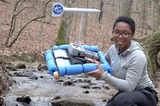
Comparing Numbers Game
- Subject:
- Cross-Curricular
- Material Type:
- Lesson
- Author:
- Kathleen Rowe
- Date Added:
- 05/20/2022

Comparing Numbers Game

Join Chesapeake Bay Foundation educators Maya, Rick, and Norah as they lead you on a journey through the Chesapeake Bay watershed. Investigate how we are all part of a watershed as you twist and turn from the Appalachian Mountains, through the rivers and streams of Piedmont, all the way down to the Chesapeake Bay. Along your journey, you’ll meet the unique critters that call the watershed home. You’ll also explore what you can do in your own neighborhood to protect the environment and become a Backyard Bay Saver!

Learn how to set up a safe backyard habitat, including the critical components to make your yard a sanctuary for wild animals. Join Wildlife Center staff and backyard naturalists to learn how we can create safe spaces to attract wildlife while minimizing our impact and chance of disturbance for our wild neighbors.

There is a lot of science to discover in your backyard! Check out this collection of activities to learn about wind, animals, plants and more.

Objective:1. Go over Rules and Court Regulations2. Set up tournament. Double Elimination bracket attached (10 teams) can be modified and website attached3. Lessons on Smash and Drop Shot from UGA.

Badminton Lesson1. Lesson Plan (serve, overhead clear and drop shot)2 UGA inforamtional video and info sheet 3. Quiz on Badminton

In this experiment, two chemicals that can be found around the house will be mixed within a plastic baggie, and several chemical changes will be observed.

Video lesson intended for grades 3-5 with a mindfulness moment, warmup, instruction and practice of basic balance and transfer of weight movements, and a sequence of two movements. Video is 15:48 minutes in length.Video created by Virginia's Chief Movement Officers cadre in collaboration with Focused Fitness, Virginia Department of Health, and Virginia Department of Education.

Exploring equality -- Mathematics Instructional Plans (MIPs) help teachers align instruction with the 2016 Mathematics Standards of Learning (SOL) by providing examples of how the knowledge, skills and processes found in the SOL and curriculum framework can be presented to students in the classroom.

Representing mean as the balance point Mathematics Instructional Plans (MIPs) help teachers align instruction with the 2016 Mathematics Standards of Learning (SOL) by providing examples of how the knowledge, skills and processes found in the SOL and curriculum framework can be presented to students in the classroom.

In computer science, a pseudocode is used to change well written words into a programming language. Programmers have to write very clearly, and have their thoughts well organized to accomplish the goal. Likewise, in balancing equations students have to approach it in a systemized way. In other words much like pseudocode, they have to solve the equation systematically to ensure the correct answer. Success in today’s “Hook” is dependent on the group’s ability to lead a blindfolded teammate through a “maze” by using only one or two word phrases. Once other members have a turn being blindfolded, students will work with a partner toward the goal of balancing equations by just using Mathematics.

This simulation serves as an introduction to balancing equations, the included student sheet by Elyse Zimmer is just one of the guided inquiry sheets available with this resource. The google form assessment will allow you to gauge student understanding after your lessons on balancing equations.

The purpose of this podcast is for students to listen and regulate emotions with a mixture of balancing as well as breathing exercises.

Students are provided situations of tax, tip, discount, and other practical consumer applications. Students need to be able to determine if their situation is a credit or debit in order to complete a checkbook register on their devices.

Learn about Bald Eagles in this episode of UNTAMED. Wildlife Center staff members discuss the conservation successes of Bald Eagles, as well as the threats that eagles still face today, including lead poisoning and vehicle collisions. Buddy, the Wildlife Center's non-releasable Bald Eagle ambassador, is featured.

In the Ball Bounce task, teams of three students collect real-time ball bounce data for two minutes to organize, display and use to form predictions. After collecting and organizing their data, students first observe how the data behave. Then they make predictions using data, scatterplots, or the equation of the curve of best fit to solve a
practical problem. This task offers students collaborative experience in using mathematical models of linear functions.

Students collect position-time data for a ball rolling down a ramp. Students then plug the data into the companion Excel document, which automatically plots the data for them. Students then answer the analysis questions on the companion document.

Teachers will implement a lesson recognizing and naming shapes. The teacher will blow up balloons (at least one for each student) and have the four different shapes drawn on them. Students will hit balloons around the room, while keeping them off the ground, in a designated area until the music stops or the teacher says freeze. Students will then grab a balloon and then identify and locate the matching shape card that is drawn on the ground or posted around the room.

Experiment with a helium balloon, a hot air balloon, or a rigid sphere filled with different gases. Discover what makes some balloons float and others sink.

Why does a balloon stick to your sweater? Rub a balloon on a sweater, then let go of the balloon and it flies over and sticks to the sweater. View the charges in the sweater, balloons, and the wall.